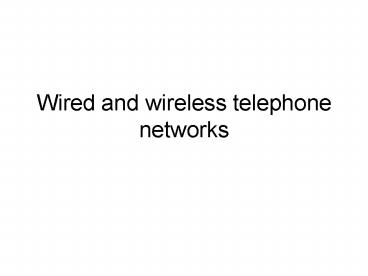Wired and wireless telephone networks - PowerPoint PPT Presentation
1 / 22
Title:
Wired and wireless telephone networks
Description:
Fiber optics connecting the switching offices carrying multiplexed ... Conversion is done by the modems and codecs. Circuit Switching (a) Circuit switching. ... – PowerPoint PPT presentation
Number of Views:45
Avg rating:3.0/5.0
Title: Wired and wireless telephone networks
1
Wired and wireless telephone networks
2
Evolution of the Public Switched Telephone System
(PSTN)
- (a) Fully-interconnected network.
- (b) Centralized switch.
- (c) Two-level hierarchy.
3
Three Major Components of the Telephone System
- Local loops
- Analog twisted pairs (category 3) going to houses
and businesses (1-10km) - Trunks
- Fiber optics connecting the switching offices
carrying multiplexed digital signals - Switching offices
- Where calls are moved from one trunk to another
(digital)
4
Structure of the Telephone System
- A typical circuit route for a medium-distance
call.
5
The Politics of Telephones
- The relationship of LATAs(Local Access and
Transport Area), LECs(Local Exchange Carrier),
and IXCs(Inter Exchange Carrier). All the
circles are LEC switching offices. Each hexagon
belongs to the IXC whose number is on it.
6
The Local Loop Modems, ADSL, and Wireless
- The use of both analog and digital transmissions
for a computer to computer call. Conversion is
done by the modems and codecs.
7
Circuit Switching
- (a) Circuit switching.
- (b) Packet switching.
8
Message Switching
- (a) Circuit switching (b) Message switching
(c) Packet switching
9
Packet Switching
- A comparison of circuit switched and
packet-switched networks.
10
The Mobile Telephone System
- First-Generation Mobile Phones Analog Voice
- Second-Generation Mobile Phones Digital Voice
- Third-Generation Mobile Phones Digital Voice and
Data
11
First generation Mobile Phones
- Push-to-talk Wireless radiophones. One
transmitter. Single channel. Half duplex. - IMTS (Improved Mobile Telephone System) One
transmitter on hilltop. 23 channels. Duplex. - AMPS (Advanced Mobile Phone System)
- Cells, microcellsgtFrequency reusegtIncreased
capacity - Base stations
- MTSO(Mobile Telephone Switching Office)
- Changing base stations Soft Handoff, Hard
Handoff
12
Advanced Mobile Phone System
- (a) Frequencies are not reused in adjacent cells.
- (b) To add more users, smaller cells can be used.
13
Channel Categories
- 832 full-duplex channels
- (824-849Mhz) upstream
- (869-894Mhz) downstream.
- Four categories
- Control (base to mobile) to manage the system
(Location registration) - Paging (base to mobile) to alert users to calls
for them - Access (bidirectional) for call setup and channel
assignment - Data (bidirectional) for voice, fax, or data
14
AMPS Communication
- Mobile phone broadcasts serial and tel. No.
- Base station tells its MTSO, which records and
informs home MTSO of location - Call
- Caller transmits its id and callee phone no.
- Base station informs callers MTSO which
allocates channel, caller switches to this
channel. - Callee is found via its home MTSO
- Callees current MTSO allocates channel and
callee switches to this channel.
15
Second Generation Mobile Telephone D-AMPS
Digital Advanced Mobile Phone System
- (a) A D-AMPS channel with three users.
- (b) A D-AMPS channel with six users.
16
D-AMPS
- Both analog and digital transmission is
supported, channels dynamically allocated. - 4-8kbps rate per user.
- Handoff is mobile assisted.
17
GSMGlobal System for Mobile Communications
- GSM uses 124 pairs of simplex frequency channels,
each of which uses an eight-slot TDM system
18
GSM (2)
- A portion of the GSM framing structure.
19
CDMA Code Division Multiple Access
- Quallcomm
- 2. and 3. generation
- 125 Mhz band
- Transmission uses entire frequency spectrum, all
the time - Algorithm
- Everyone transmits his own message using his
unique symbol - Sum is received
- Decoding of a particular users message by using
his symbol
20
CDMA
- (a) Binary chip sequences for four stations
- (b) Bipolar chip sequences
- (c) Six examples of transmissions
- (d) Recovery of station Cs signal
21
Third-Generation Mobile PhonesDigital Voice and
Data
- Basic services an IMT-2000 network should provide
- High-quality voice transmission
- Messaging (replace e-mail, fax, SMS, chat, etc.)
- Multimedia (music, videos, films, TV, etc.)
- Internet access (web surfing, w/multimedia.)
- Videoconferencing, group game playing
22
Third-Generation Mobile Phones
- UMTS (W-CDMA)
- Ericsson
- Direct sequence spread spectrum
- UMTS to GSM handoff possible
- CDMA2000
- Qualcomm
- Direct sequence spread spectrum
- Backward compatible with 2. generation CDMA
system (IS-95) - GPRS (General Packet Radio Service)
- Overlay packet network on top of GSM.
- Send and receive IP packets.
- Pay per packet transfer
- EDGE/EGPRS Enhanced Data rates for GSM
Evolution-2.5G) - 48 kbps for each timeslot and upto 8 timeslots































